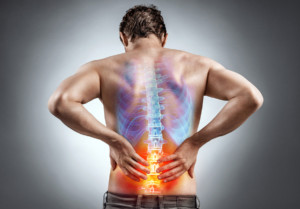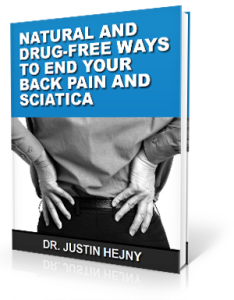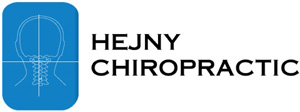 If you are suffering from back pain, you are not alone. “About 31 million Americans experience low back pain at any given time,” the American Chiropractic Association reported. Back pain is the leading cause of disability worldwide, which obstructs people from working and performing other day-to-day activities.
If you are suffering from back pain, you are not alone. “About 31 million Americans experience low back pain at any given time,” the American Chiropractic Association reported. Back pain is the leading cause of disability worldwide, which obstructs people from working and performing other day-to-day activities.
While it is prevalent and can cause a great deal of discomfort, the condition is rarely serious. It can affect people of any age but is mostly seen in adults who are 35 to 55 years old. Back pain occurs because something is off in the way your spinal joints, muscles, discs, and nerves fit together and move. Additionally, lower back pain may be due to a problem in the following areas:
- Ligaments around the spine and discs
- Spinal cord and nerves
- Bony lumbar spine
- Discs between the vertebrae
- Abdominal and pelvic internal organs
- Lower back muscles
Table of Contents
What Causes Your Back to Hurt?
The back anatomy consists of an intricate structure of healthy bones, flexible ligaments and tendons, huge muscles, and highly sensitive nerves. Discs, or cartilage-like pads, cushion the different parts of the spine. Back pain happens if any one of these sections malfunction. Some of the common underlying causes of back pain include:
- Strain: This is when back muscles and ligaments become stretched too far, and muscle spasms may follow. This can be prompted several things:
-
- Extreme physical exertion
- Bending or crouching repeatedly
- Abrupt and awkward movements
- Lifting heavy objects without proper lifting technique
- Structural problems:
- Bulging discs: A disc cushions each vertebra. If it swells, it can put pressure on the nerves and cause back pain.
- Ruptured discs: Like a bulging disc, a broken disc puts excessive pressure on nerves and causes back pain.
- Abnormal curvature of the spine: When the natural curves of the spine are misaligned, such as with scoliosis, back pain happens as a result.
- Arthritis: The cartilage of the facet joints in the spine breaks down. As a result, movement of the bones causes the formation of bony outgrowths called spurs. These spurs can press on nerves, leading to back pain.
- Osteoporosis: Bones and vertebrae of the spine lose mass and become porous and brittle, causing fractures.
- Sciatica: This is a sharp, stabbing pain that extends from the lower back through the back of the thigh and down through the leg, and is often due to a swollen or herniated disc pressing on a nerve.

- Infection of the spine: The bones and discs around the spinal cord may become infected by bacteria or fungal organisms. Symptoms of spinal infection include back pain, fever, and swelling or warmth and redness around the area of infection.
- Cancer of the spine: A tumor in the spinal column presses on sensitive nerve endings, causing instability of the spine or paralysis.
- Cauda equina syndrome: This is a complication brought by compression of the nerves at the end of the spinal cord. This syndrome causes lower back pain, numbness or tingling in the buttocks and lower extremities (sciatica), and weakness in the legs.
- Additional infections: Bladder, kidney, or pelvic inflammatory diseases can also be underlying causes of back pain.
- Sleep disorders: The lack of adequate sleep prohibits muscles from having a chance to re-energize, and that can trigger back pain.
- Shingles: Reactivation of the varicella-zoster virus inflames the sensory nerves, resulting in pain that radiates from the back to the front of the chest.
- Poor posture or everyday activities:
- Straining the neck forward like when using a computer or driving
- Bending down for long periods
- Carrying something incorrectly
- Bending awkwardly
- Standing for long periods
- Pushing or pulling something
- Coughing or sneezing
- Overstretching
Who Is at Greater Risk for Back Pain?
People of all ages can suffer from back pain, but these people are at greater risk:
- Females, due to inflexible pelvic structure and hormonal factors
- Pregnant women
- Older adults
- Those working a stressful job
- Those who are living an inactive lifestyle
- Those who smoke
- Those with anxiety or depression
- Those doing strenuous physical work or exercise
Where Can You Find Natural Relief Care for Back Pain?
Most people seeking natural back pain relief options turn to chiropractic relief because of its effectiveness and long-lasting relief. Around 22 million Americans visit chiropractors annually. Upper cervical chiropractic is a specialty in the chiropractic profession. It is the best alternative there is to heal back pain as it addresses the very root cause of it.
At Hejny Chiropractic in Spring Lake Park, Minnesota, we help our patients with sciatica by targeting the bones of the upper cervical spine, particularly the C1 and C2 vertebrae. Any trauma or injury may impact the head or neck, causing these spinal bones to misalign and eventually shifting the spine. As the spine moves, nerves and muscles become stressed and strained, which can lead to various kinds of sciatica and related disorders.
If you’re looking for a Minnesota chiropractor for low back pain, go ahead and call Hejny Chiropractic. We perform thorough tests on our patients to see if they have a misalignment. We then use a gentle and precise method that is scientifically proven to help the bones return to their normal position without forceful popping or cracking of the spine. Once the misalignment is corrected, the body can then begin to heal itself from the damage. As the body starts to recover and inflammation calms down, patients can say goodbye to their sciatica.
To schedule a complimentary consultation with Dr. Hejny, call our Spring Lake Park office at 763-230-0116. You can also click the button below.
 If you are outside of the local area, you can find an Upper Cervical Doctor near you at www.uppercervicalawareness.com.
If you are outside of the local area, you can find an Upper Cervical Doctor near you at www.uppercervicalawareness.com.
